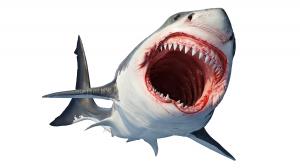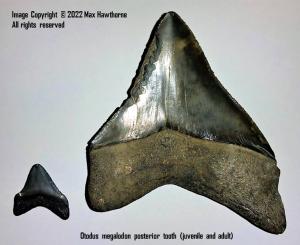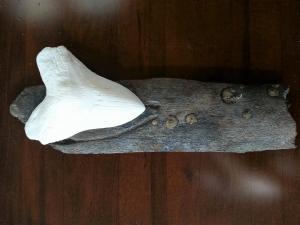
Researcher’s fossil evidence disputes cold water Megalodon theory, suggests the largest sharks came from temperate climates and were breeding females.
— Max Hawthorne
BUCKINGHAM, PA, US, May 23, 2022 /EINPresswire.com/ — Award-winning author and independent paleontologist Max Hawthorne, best known for his Kronos Rising series of sci-fi thrillers, is also a bit of a Megalodon junkie. Several years ago, Hawthorne “made waves” with his radical Megalodon Scavenger Theory, suggesting that, as the extinct mackerel shark became bulkier and more cumbersome over the course of its ontogeny, it gradually transitioned from a primary predator and opportunistic scavenger to a primary scavenger and opportunistic predator.
Hawthorne has come forward in response to a recent study by the University of Chicago, which suggests that the biggest Megalodon sharks were found in higher latitudes and colder climates, whereas the smallest ones came from lower latitudes and warmer waters. It also suggests that more temperate locations traditionally believed by researchers to be Megalodon nurseries may not have been. The teeth believed to be from baby Megalodons may simply have been from sub-adults.
Hawthorne believes there are potential holes in the theory, based on a plethora of fossils from his personal collection. “I find myself in disagreement with portions of the ‘cold water giants’ theory,” he stated. “For examples, I own several tiny Megalodon teeth from the Hawthorn formation of North-central Florida. They’re 5-12 million years old. One anterior tooth has an enamel height of less than .75 inches which, per traditional formulas, suggests a newborn shark. We’re also talking a lower latitude and a still-warm climate. That indicates that baby sharks were in that region at that time.”
Another issue Hawthorne has with the cold water theory is evidence he possesses of what may have been the largest sharks ever. “I have an extensive fossil collection, including a section of whale rib with a spectacular gouge from a scavenging Megalodon. You can see where the flared-out cusps of one of its tooth crowns gouged deeper into the rib as the tooth slid between it and the next rib. When you compare that gouge to, say, a six-inch tooth, you see it could’ve never done the job. The shark that fed on this whale had anterior teeth that were likely at least seven inches long. This fossil hails from the Miocene strata of the Lee Creek mine in North Carolina. Granted, that is a higher latitude, but it’s also Lower Miocene, which means overall temperatures were hotter.”
The question of tooth size in the adults, is, for Hawthorne, the big fly in the ointment. “It used to be that, if you had an impressive lateral or posterior tooth and wanted to do a size estimate of the tooth’s former owner, it was difficult; there were no complete Megalodon jaws. Now there are two, CB-11 and CH-31, both of which have 46 teeth,” the author stated. “I have in my possession an assortment of massive posterior teeth. By scaling them up based on the matching tooth in the complete sets, we’re able to get an idea of how big the sharks were. And, of course, we also know where they were when they lost their teeth.”
Hawthorne focused on three Megalodon teeth from his collection. “Before getting into details, let me preface by saying we’re going to use teeth from specimen CB-11 as a reference. It’s the bigger of the two, with the largest anterior tooth (UL1) measuring 146 mm (5.75 inches) in slant height. I’m also going to focus primarily on tooth width for comparisons. I believe it will be more consistent in terms of overall jaw size. Last, but not least, to confirm placement of each of the assorted teeth in the jaw, I consulted with Seth Sorensen, Chief Paleontologist and President of The Fossil Shack and American Fossil. I am extremely grateful to him for loaning me his expertise; his assistance was invaluable.”
Before crunching numbers, Hawthorne touched on locations. “The first of the teeth we’re going to reference is from St Mary’s River on the Florida/Georgia border. It’s Early Pliocene/Late Miocene. That means it’s from a lower (warmer) latitude and a warm-to-cool time period.” In terms of stats, Hawthorne stated, “This is an UR11, meaning upper right eleven, AKA the next to last tooth. The same tooth in CB-11 is 50mm wide. Mine is 66.5mm. That suggests that, scaled up from CB-11’s 146mm, the biggest anterior tooth in the jaw would have been ~194mm in height, or 7.6 inches. A giant female shark.”
His next two teeth both hail from St. Catherine’s Sound in Georgia and are Late Miocene (11.65-5.33mya), suggesting a hot-to-warm climate, with a lower/warmer latitude. “Both of these teeth are a bit disturbing, as they suggest that not only were the sharks in that region huge, breeding females, they may have been the largest Megalodon sharks ever. For example, one tooth is a confirmed UR12 (upper right, most posterior/smallest tooth). In CB-11, that same tooth is 48mm wide. Mine is 69.5mm. Morphological changes notwithstanding, that suggests the largest anterior tooth in this shark’s mouth was 1.45x as wide, i.e., 211.7mm or 8.33 inches. Astonishing. And the last tooth – which, by the way, I have a juvenile version of which was found in the exact same spot – is even scarier. It’s either an LR9 (lower right 9) or an LR10 – it’s difficult to say. The tooth is enormous, 1.42x as high and 1.54x as wide as the #9 tooth in CB-11, suggesting a maximum upper anterior tooth length of 207mm (8.16 inches) scaled up from height, and 225mm (8.85 inches) scaled up from width. If compared to the same tooth in CH-31, it’s even bigger. And I don’t want to even THINK about the possibility of that tooth being an LR10 (which, based on root shape, it may be) because the implications are borderline ridiculous. The bottom line is that these teeth overwhelmingly suggest that the biggest Megalodon sharks we currently have evidence of both swam and gave birth off the coast of what is now the USA. They were in temperate waters, and also in warmer climates.”
Kevin Sasaki
Media Representative
+1 267-337-7545
[email protected]
Visit us on social media:
Facebook
Twitter
Other
![]()
Sports News - USA SPORT NEWS originally published at Sports News - USA SPORT NEWS



 ,
,
